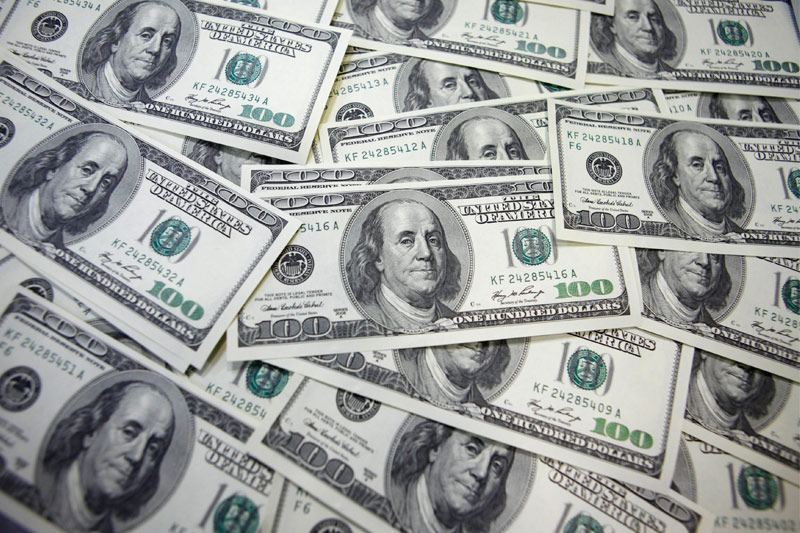Investing.com - The dollar dropped against most major global currencies on Friday as data pointed to central banks in the U.S. and China taking steps to stimulate their economies via loose monetary policy measures.
In China, second-quarter economic growth figures met expectations but were still low, sparking talk of interest-rate cuts while in the U.S., soft consumer sentiment figures fueled sentiment the Federal Reserve will roll out quantitative easing measures to stave off economic decline.
In U.S. trading on Friday, EUR/USD was trading up 0.29% at 1.2239.
China's gross domestic product grew 7.6% in the second quarter, largely in line with expectations, which sparked demand for riskier currencies and asset classes that sent the dollar falling and the currencies like the euro rising.
However, China's economy grew a more robust 8.1% in the first quarter of this year, and the cool-down in the second quarter fueled sentiment China may cut interest rates and take other steps to steer its economy to more robust growth rates down the road, which further fueled the risk-on trading session.
In the U.S., soft consumer sentiment figures rekindled talk the Federal Reserve will roll out credit easing measures that would weaken the dollar in exchange for more accelerated recovery.
In the U.S., the Thomson Reuters/University of Michigan's preliminary reading on the overall index on consumer sentiment fell to 72.0 in July from 73.2 in June.
Analysts were expecting a 73.4 reading.
The news gave investors room to shrug off a Moody's decision to downgrade Italian ratings.
Moody’s cut Italian government bond rating by two levels to Baa2 and warned additional downgrades may be on the way.
A Baa2 bond rating hovers just two levels above junk bond status.
Meanwhile in the U.S., the Bureau of Labor Statistics reported that producer prices rose unexpectedly in June, climbing to a seasonally adjusted 0.1%, from -1.0% in May.
Analysts had expected U.S. producer price index to fall -0.5% last month.
The greenback, meanwhile, was down against the pound, with GBP/USD trading up 0.87% at 1.5562.
The dollar was down against the yen, with USD/JPY trading down 0.10% at 79.24, and down against the Swiss franc, with USD/CHF trading down 0.26% at 0.9814.
The dollar was down against its cousins in Canada, Australia and New Zealand, with USD/CAD down 0.35% at 1.0155, AUD/USD up 0.79% at 1.0219 and NZD/USD up 0.54% at 0.7941.
The dollar index, which tracks the performance of the greenback versus a basket of six other major currencies, was down 0.35% at 83.49.
In China, second-quarter economic growth figures met expectations but were still low, sparking talk of interest-rate cuts while in the U.S., soft consumer sentiment figures fueled sentiment the Federal Reserve will roll out quantitative easing measures to stave off economic decline.
In U.S. trading on Friday, EUR/USD was trading up 0.29% at 1.2239.
China's gross domestic product grew 7.6% in the second quarter, largely in line with expectations, which sparked demand for riskier currencies and asset classes that sent the dollar falling and the currencies like the euro rising.
However, China's economy grew a more robust 8.1% in the first quarter of this year, and the cool-down in the second quarter fueled sentiment China may cut interest rates and take other steps to steer its economy to more robust growth rates down the road, which further fueled the risk-on trading session.
In the U.S., soft consumer sentiment figures rekindled talk the Federal Reserve will roll out credit easing measures that would weaken the dollar in exchange for more accelerated recovery.
In the U.S., the Thomson Reuters/University of Michigan's preliminary reading on the overall index on consumer sentiment fell to 72.0 in July from 73.2 in June.
Analysts were expecting a 73.4 reading.
The news gave investors room to shrug off a Moody's decision to downgrade Italian ratings.
Moody’s cut Italian government bond rating by two levels to Baa2 and warned additional downgrades may be on the way.
A Baa2 bond rating hovers just two levels above junk bond status.
Meanwhile in the U.S., the Bureau of Labor Statistics reported that producer prices rose unexpectedly in June, climbing to a seasonally adjusted 0.1%, from -1.0% in May.
Analysts had expected U.S. producer price index to fall -0.5% last month.
The greenback, meanwhile, was down against the pound, with GBP/USD trading up 0.87% at 1.5562.
The dollar was down against the yen, with USD/JPY trading down 0.10% at 79.24, and down against the Swiss franc, with USD/CHF trading down 0.26% at 0.9814.
The dollar was down against its cousins in Canada, Australia and New Zealand, with USD/CAD down 0.35% at 1.0155, AUD/USD up 0.79% at 1.0219 and NZD/USD up 0.54% at 0.7941.
The dollar index, which tracks the performance of the greenback versus a basket of six other major currencies, was down 0.35% at 83.49.
